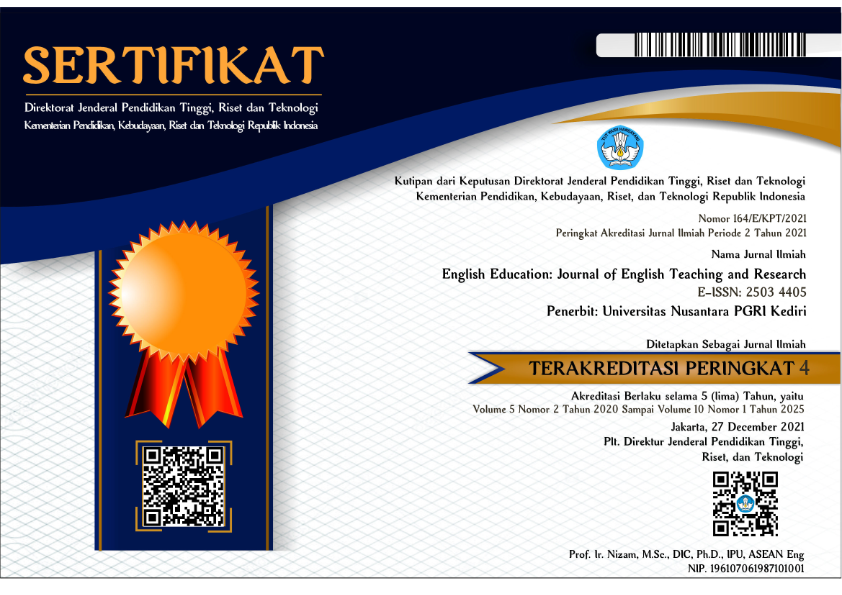Investigating EFL Students’ Environment Analysis on English Speaking Competencies at Senior High School
DOI:
https://doi.org/10.29407/jetar.v9i1.21725Keywords:
environment analysis; English speaking; senior high schoolsAbstract
English speaking is one skill or competence of English that should be owned by EFL students in the era of 21stcentury. Thus, each EFL student needs to achieve the abilities of oral communication in English better. However, teachers of English often neglect the students’ constraints in learning English. Not many studies are discussing about environment analysis on English speaking competencies. This study aims to analyze EFL students’ environment on English speaking in senior high schools. This current study employed a qualitative design to capture the students’ responses on learning environments. The participants of this study were four students of senior high school level in state and private schools in Jakarta and Depok, West Java, Indonesia. The results showed that EFL students’ interest, motivation, time, and their classroom significantly could impact their English-speaking ability. Thus, this study recommends that teachers of English should motivate the students to learn English better and accommodate them with comfortable classroom.
Downloads
References
Adhani, O. F., Fadhillah, A. N., Yahya, R. A., & Wintolo, T. (2023). EFL Students ’ Perceptions on the Use of TikTok in Improving Speaking Skill. 8(2), 180–188.
Amin, F. (2019). Positive Classroom Environment , Cooperative Learning Strategy , Reading Comprehension Achievement : a Correlational Study. LangEdu Journal.
Apriliyanti, R., Mujiyanto, J., & Karya Husada Semarang, S. (2018). English Education Journal The Correlation Between Interest, Motivation, English Self-Concept and English Speaking Performance in Nursing Students. Eej, 8(2), 138–147.
Asrobi, M., Seken, K., & Suarnajaya, M. (2013). The Effect of Information Gap Technique and Achievement Motivation toward Students’ Speaking Ability(An Experimental Study of the Tenth Grade Students of MAN Selong). E-Journal Program Pascasarjana Universitas Pendidikan Ganesha Program Studi Bahasa Inggris, 1, 1–12.
Aulia, N. A. N., & Apoko, T. W. (2022). Self-Confidence and Speaking Skills for Lower Secondary School Students: A Correlation Study. Journal of Languages and Language Teaching, 10(4), 551–560.
Basa, I. M., Asrida, D., & Fadli, N. (2018). Contributing Factors to the Students’ Speaking Ability. Langkawi: Journal of The Association for Arabic and English, 3(2), 156. https://doi.org/https://doi.org/10.31332/lkw.v3i2.588
Brevik, L. M. (2019). Gamers, surfers, social media users: Unpacking the role of interest in English. Journal of Computer Assisted Learning, 35(5), 595–606. https://doi.org/https://doi.org/10.1111/jcal.12362
Fatkhiyati, N. R., & Diponegoro, U. (2018). Environment Analysis: Designing an ESP Curriculum for the Students of Early-childhood education in PAUD As-Salam. November, 22–23.
Gana, M., Haryanto, & Salija, K. (2018). Teachers’ Strategies in Teaching Speaking (a Case Study of an English Teacher in Sma Negeri 1 Toraja Utara). Teachers’ Strategies in Teaching Speaking, 4.
Humphries, S. C., Burns, A., & Tanaka, T. (2015). “My head became blank and I couldn’t speak”: Classroom factors that influence English speaking. The Asian Journal of Applied Linguistics, 2(3), 164–175.
King, J. (2013). Silence in the second language classrooms of Japanese Universities. Applied Linguistics, 34(3), 325–343. https://doi.org/10.1093/applin/ams043
Kurniawati, L. A. (2021). Module of Curriculum and Material Development.
Lucas, R. I., Pulido, D., Miraflores, E., Ignacio, A., Tacay, M., & Lao, J. (2010). A study on the intrinsic motivation factors in second language learning among selected freshman students. Philippine ESL Journal, 4(1), 3–23. https://citeseerx.ist.psu.edu/document?repid=rep1&type=pdf&doi=e54ce6336efd27e374dc37bafea71d542ed7a742
Macalister, J., & Nation, I. S. P. (2019). Language Curriculum Design. In Language Curriculum Design. https://doi.org/10.4324/9780429203763
Mangal, S. K. . (2017). Essential Of Educational Psychologi (11 Printin).
Miles, M. B., Huberman, A. M., & Saldana, J. (2014). Qualitative Data Analysis: A Methods Sourcebook. In Practitioner Research and Professional Development in Education (3rd ed.). https://doi.org/10.4135/9780857024510.d49
Mukminin, M., Habibi, A., Asyrafi, A., Makmur, F., & Marzulina, M. (2018). “If our English isn ’t a language, what is it?” Indonesian EFL Student Teachers’ Challenges Speaking English. 23(1), 129–145.
Pratiwi, N. P. A., Suryani, I., & Suarnajaya, I. W. (2020). Investigating the inhibiting factors in speaking English faced by senior high school students in Singaraja. International Journal of Language Education, 4(1), 48–58. https://doi.org/10.26858/ijole.v4i2.10054
Rao, P. S. (2019). The Importance of Speaking Skills in English Classrooms. Alford Council of International English & Literature Journal (ACIELJ), 561(3), S2–S3. https://www.researchgate.net/profile/Parupalli-Rao/publication/334283040_THE_IMPORTANCE_OF_SPEAKING_SKILLS_IN_ENGLISH_CLASSROOMS/links/5d21b2db458515c11c18dbf3/THE-IMPORTANCE-OF-SPEAKING-SKILLS-IN-ENGLISH-CLASSROOMS.pdf
Richards, J. C., & Renadya, W. A. (2002). Methodology in Language Teaching: An Anthology of Current Practice (pp. 1–432).
Taylor, S. J., Bogdan, R., & DeVault, M. (2015). Introduction to qualitative research methods: A guidebook and resource. John Wiley & Sons.
Ummi, A., & Shp, F. (2022). the Lack of Interest in Learning English in Senior High School During Pandemic Covid 19. 2(3), 1–8.
Wahyuningsih, S., & Afandi, M. (2020). Investigating English Speaking Problems: Implications for Speaking Curriculum Development in Indonesia. European Journal of Educational Research, 9(3), 967–977. https://doi.org/https://doi.org/10.12973/eu-jer.9.3.967
Zhang, X., Dai, S., & Ardasheva, Y. (2020). Contributions of (de)motivation, engagement, and anxiety to English listening and speaking. Learning and Individual Differences, 79, 101856. https://doi.org/https://doi.org/10.1016/j.lindif.2020.101856
Downloads
Published
Issue
Section
License
Copyright (c) 2024 Prisca Apriana Harahap, Hanifah Khairunisa, Shifa Ananda, Tri Wintolo Apoko

This work is licensed under a Creative Commons Attribution-ShareAlike 4.0 International License.
Authors who publish with this journal agree to the following terms:
- Copyright on any article is retained by the author(s).
- The author grants the journal, the right of first publication with the work simultaneously licensed under a Creative Commons Attribution License that allows others to share the work with an acknowledgment of the work’s authorship and initial publication in this journal.
- Authors are able to enter into separate, additional contractual arrangements for the non-exclusive distribution of the journal’s published version of the work (e.g., post it to an institutional repository or publish it in a book), with an acknowledgment of its initial publication in this journal.
- Authors are permitted and encouraged to post their work online (e.g., in institutional repositories or on their website) prior to and during the submission process, as it can lead to productive exchanges, as well as earlier and greater citation of published work.
- The article and any associated published material is distributed under the Creative Commons Attribution-ShareAlike 4.0 International License








 Article template
Article template



